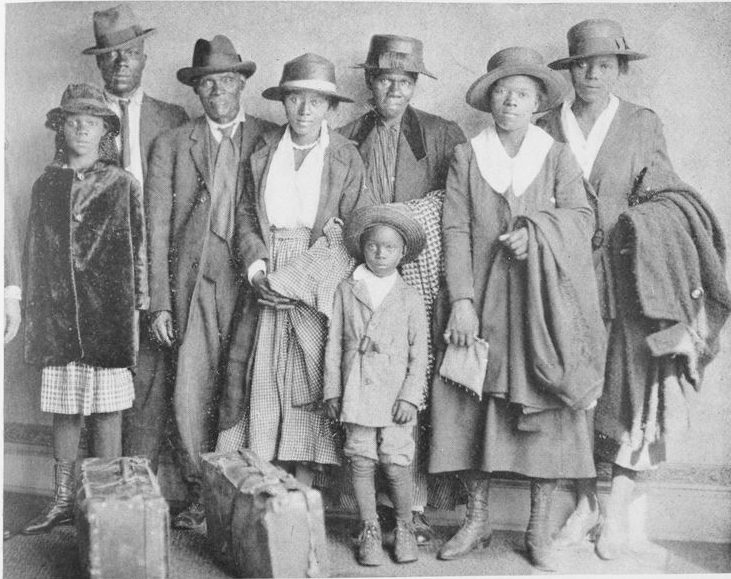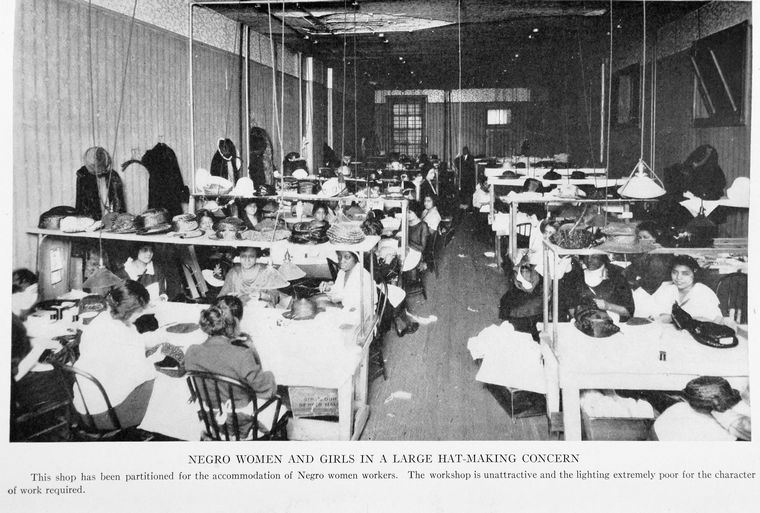Background
From 1910 to 1940, the Black population of Chicago grew from 44,000 to 234,000. The twentieth-century movement of Black families from the rural South to the urban North is known as the Great Migration. Chicago, Detroit, and New York were most affected by this movement, but it included all Northern cities.
Migration was often a family affair. Many women chose to migrate not only for themselves, but also for their loved ones. Mothers worried that their children would grow up in extreme poverty. Young women faced sexual and physical exploitation by white landowners. Young men faced violence and lynching. There was hope in moving away.
Life in Chicago was not perfect, but it was often an improvement. Women and young girls could earn up to twice as much in the North than in the South for the same work. More girls had access to public education, and Black women’s clubs offered social services and opportunities for political involvement.
About the Image
In 1919, a violent race riot spread through Chicago. In response, the governor of Illinois established the Chicago Commission for Race Relations. The interracial commission studied the causes of the riot and recommended policies to prevent a repeat event. The Commission’s findings were published in 1922. It was the largest study of white and Black relations of its time and continues to be an important source for studying the Great Migration today.
This is a set of three photographs included in the Chicago Commission on Race Relations’ report.
The first image shows an African American home on a plantation in the rural South. It is an example of the types of homes many migrant families left behind.
The second image shows a migrant family newly arrived in Chicago after leaving the rural South.
The final image shows women and girls working in a hat-making factory. Although the caption describes the work environment as “unattractive,” many of the women in this image might have considered themselves lucky. The vast majority of Black women workers worked as domestic servants in Chicago homes. Most factory work was reserved for white workers. But there were rare exceptions, like this hat-making shop. Many of the women in this image may have been highly educated. Women who had received high school and college degrees in the South found that the only work available to them in the North was factory and domestic work. Even women who were teachers in the South took manual labor jobs in the urban North.
Vocabulary
- commission: A group of people assigned a specific task or project. A term often used in government work.
- domestic work: Work in the home, including cooking, cleaning, laundry, and child care.
- interracial: Including people of different races.
- lynching: The illegal execution of a person by a mob.
- migration: Movement from one place to another.
Discussion Questions
- What story do these three images tell? What can you learn about the experience of women and young girls who migrated north?
- What do you notice about the plantation house? What do you think it was like to move from a house like this to the busy streets of Chicago?
- What do you notice about the family in the second image? In particular, what do you notice about the women and girls? What are their facial expressions? What might this tell you about their situation?
- What do you notice about the factory floor in this image? Why would women consider themselves lucky to work in such a factory?
Suggested Activities
- Lesson Plan: In this lesson designed for fourth grade, students will learn about the experiences of African Americans during the Great Migration.
- Connect these images to Fannie Barrier Williams’s article in the Chicago Defender and discuss the lives of Black women in Chicago in the early twentieth century.
- Pair these photographs with the life story of Ida B. Wells, the anti-lynching crusader who escaped death threats by moving to Chicago.
- Combine this resource with an article about Black suffragists and a photograph of the NAACP’s Silent March to understand how women in the Great Migration found opportunities to be politically active.
- Deepen your understanding of this history by exploring the Great Migration resources in our Black Citizenship in the Age of Jim Crow curriculum.
- Connect these images with the photograph of African American college students attending a football game and the life story of Madame C.J. Walker. Consider how young migrants embraced beauty and consumer culture as a way of celebrating their new urban lives.
Themes
IMMIGRATION, MIGRATION, AND SETTLEMENT









